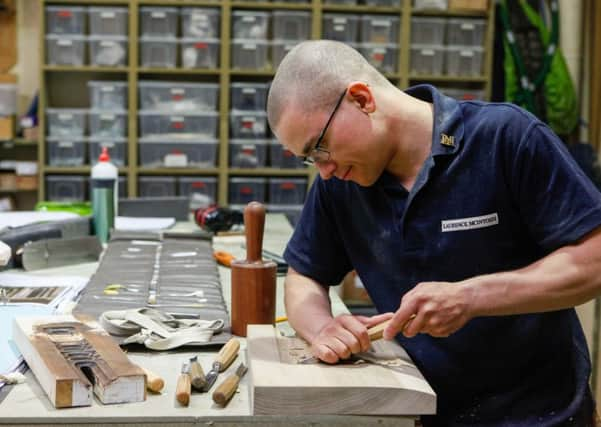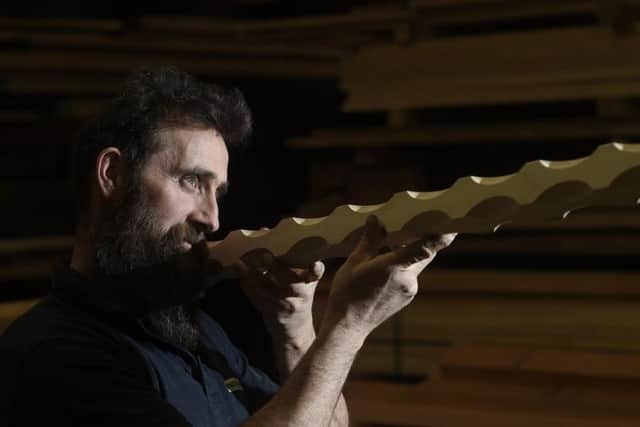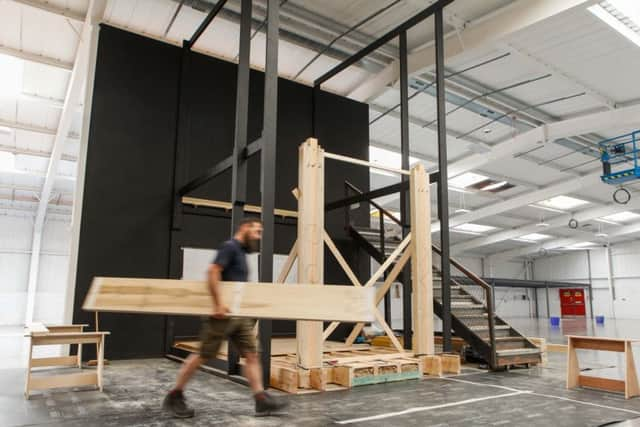Mission to create the Mack Mark II


The room is an assault on the senses: the sweet aroma of Douglas Fir, the deafening whirr of the cutting machines, the sight of wood shavings, like giant Parmesan curls, piling up on the floor. All around lie pieces of timber: some rough-hewn, others so silky smooth you feel compelled to run your fingers along them. Cirulis, however, is completely focused on the task in hand: copying the pierced ovals on the pendants that once hung in one of the 20th century’s greatest architectural treasures – the Charles Rennie Mackintosh-designed library in the Glasgow School of Art (GSA).
Here, at the appositely named Laurence McIntosh Ltd, just a stone’s throw from the ruins of Craigmillar Castle in Edinburgh, a minor miracle is taking place. The art nouveau masterpiece – burnt to the ground when fire swept through the building in May, 2014 – appears to be rising from the ashes. Using the same materials and techniques as Mackintosh, an elite team are meticulously recreating individual components: the posts that supported the balcony, the balustrades with their scalloped spindles, the pendants. These components are then transferred to an adjacent building ready for assembly.
Advertisement
Hide AdAdvertisement
Hide AdThe structure taking shape in this building – soon to be Laurence McIntosh’s permanent home – is a life-size prototype of one of the library’s six bays. Later this month, the finished article will be examined by a three-strong panel of experts; if it wins approval, the company will be asked to reproduce the entire room the way it was when it was signed off by the GSA in 1910.


To those involved, this is more than a job, it is an obsession: evidence that, more than 100 years after Mackintosh drew up his original designs, the desire to realise an artistic vision can still be all-consuming. “It’s been a real eye-opener, the level of detail you have to go into and the passion that lies behind the reconstruction of such an iconic building,” says Laurence McIntosh co-owner David MacDonald, a vivacious man with snow-white hair. “You end up eating, sleeping and breathing it. It’s crazy; the guys doing the drawings, the guys on the machines, the carvers, the installers – they are all thinking about it all the time, identifying issues and trying to find ways around them.”
The challenges of this reconstruction are complex and many. The GSA’s brief is to replicate the original, but hardly anything survived the blaze, and, in any case, many modifications had taken place over the course of the century, with years of over-painting and smoking causing the wood to darken in tone.
Though there is plenty of source material – original plans, old photographs and scale drawings – some of it is contradictory, and it is difficult to discern the depth of a carving or the precise shade of wood-stain from 2D images.
There are also logistical challenges posed by changing times and practices. In Mackintosh’s day, the tulip wood used in the library’s construction grew tall and wide in virgin forests across north America. Now it is farmed and harvested as soon as it reaches a certain height; and it is kiln-dried as opposed to air-dried, making it more brittle to work with.


After being told by US companies the wood could not be supplied in the dimensions required to create the pendants, MacDonald managed to locate an alternative European supplier. He also tracked down the horse-hair matting, used as insulation, and the original nails to a company in Massachusetts that had bought over the Glasgow plant and machinery in the 1970s.
As neither glues nor screws were used in the building of the library, the joiners had to learn to attach fixings to the walls by hammering “dooks” or wooden plugs into the gaps between the bricks, and to stain the wood using a precise mixture of oil-based paints (before finishing it off with beeswax and turpentine).
Advertisement
Hide AdAdvertisement
Hide AdWhen it came to the carvings and colourings, much experimentation was required. Multiple jigs were created before those involved were confident the scallops on the balustrade spindles were the right size, and 50 or 60 samples – involving different combinations of raw and burnt umber – were produced in an effort to find the right shade for the staining.
Creating the prototype, then, is a long and laborious process. There are a myriad decisions to take, and every single one must be approved by Page/Park Architects, the company leading the overall restoration of the Mack, and by the GSA.


“Everything you do makes a difference,” says lead craftsman Angus Johnston, who, with his shorts, boots and shaggy beard, looks as if he is auditioning for the role of woodcutter in a Hans Christian Andersen story.
While studying furniture-making and cabinetry at Shrewsbury College of Art and Technology, he wrote a thesis on Mackintosh, little imagining that many years later he would have a chance to recreate the architect’s most iconic work.
“Everything you do makes a subtle difference. If you over-sand the wood before you apply the stain, it takes on a different colour. And the method of rubbing on, rubbing off is important too,” says Johnston.
“We have worked out a process of sanding everything to the same grade, wiping everything on, leaving it on the same amount of time, wiping it off at the same point, so we achieve as even a finish over the whole surface as possible.”


At the same time, it must not look too perfect; the GSA library was built on a tight budget with a team of craftsmen who formed a manual production line. The quality of the work varies according – perhaps – to when it was done: first thing on a Monday morning, or on a Friday afternoon when the first pint of the weekend beckoned.
Advertisement
Hide AdAdvertisement
Hide AdThe paintwork also has to look a little rushed. Johnston lifts a spindle to show me how the first attempts at the scallops – painted green, red, white and blue – were too smooth and glossy; later efforts are rougher, and you can see the brush-strokes.
“In some ways the room was actually fairly badly put together and we are going to have to try to replicate that,” Johnston says. “When we’re finished, one set of people will probably ask: ‘Why is it so badly made?” while others, who know more about it, will say: ‘That is too good’. We are trying to pitch it somewhere in the middle.”
Long before Laurence McIntosh was tasked with building the prototype of the bay, Natalia Burakowska from Page/Park was forming her own intense attachment to the library and its creator.
Burakowska, who emigrated to Scotland from Poland, has a degree in archaeological conservation and an interest in timber structures, so when she found out the company was bidding for the restoration contract, she asked to be involved.
At this point, the decision to go back to 1910 had already been taken, but no-one was sure exactly what that meant. Burakowska began liaising with experts and sifting through the archives in an attempt to gain a clearer picture. By scrutinising plans and photographs, she was able to establish which cabinets were present more or less from the outset and which were added later. The later cabinets – along with the radiators and an internal staircase to the mezzanine, which were installed at the behest of chilly and footsore librarians – will be left out of the reconstruction.
Burakowska’s extensive research means she has an unparalleled grasp of the history of the building and the challenges of remaking it. In the beginning, she explains, no-one knew for sure what wood had been used to construct the bays.
“Someone – I’m not sure who – said they thought it was Kauri Pine,” she says. “That caused a panic because Kauri Pine is a protected species and we thought we were going to have to write letters to the government in New Zealand asking if we could cut down the last one,” she says.
Advertisement
Hide AdAdvertisement
Hide AdStudying the original committee minutes and correspondence between the then GSA director, Francis Newbery, and Mackintosh’s practice, Honeyman & Keppie, has also given Burakowska unprecedented insight into the architect’s unyielding nature.
When the GSA pushed for a balcony across the west windows to be scrapped on the grounds it would restrict the light, Honeyman & Keppie insisted doing so would push up the cost. “That is obviously untrue,” laughs Burakowska, “but it shows that if Mackintosh really wanted something, he was willing to lie to get it.”
Some of the later modifications would surely have offended his aesthetic sensibilities. Photographs taken in 1910 show nothing within the library was allowed to exceed the height of the window sills. The original chairs are low-backed to the point of discomfort so as not to spoil the line of the building. Yet the radiators installed in the 1920s project above them. Advances in technology mean this time round, the temperature will be boosted by underfloor heating, one of the very few concessions to modernity.
In the immediate aftermath of the blaze, when the city was still in mourning, there was intense debate over the fate of the library. Some people argued a replica would have all the atmosphere and authenticity of a stage set, and that it would be better to come up with something more functional. Others insisted tacking a modern room on to the Mack would be like painting a crop-top on the Mona Lisa. The GSA, however, was always committed to recreating the original art work. “Less a pastiche than a fresh iteration of an existing score,” as spokesperson Lesley Booth puts it.
Witnessing the passion the project has generated suggests this was the right decision. Not only has it rekindled interest in Mackintosh, it has been the catalyst for the revival of traditional skills that might otherwise have disappeared.
In 1910, the architect would have had his pick of classically trained carvers; “I imagine you would have been able to go down to the shipyards and ask for half a dozen men,” says Booth. Today, there are only a handful dotted around Scotland and very few joinery companies that could have taken on a job of this complexity.
At present, only a small number of Laurence McIntosh employees are working full-time on the prototype, with Cirulis – who learned his trade in his native land – responsible for almost all the carving, but the company has four apprentices who are peripherally involved. If and when it is given the full contract, a bigger team will be assembled and more apprentices taken on.
Advertisement
Hide AdAdvertisement
Hide AdCharlie Symington is just 17. A little shy, he lights up when he talks about his first day in the workshop. “I had been on a media course and didn’t like it,” he says. “But when I arrived here, they were making a pool room. It was awesome to see it grow and I knew this was what I wanted to do.”
So far, Symington has been mostly sanding; he is too young to use the machines just now, but as the GSA project progresses he will do more. “For a young lad to be able to say: ‘I worked on the Glasgow School of Art project’ – that’s a great feather in his cap,” MacDonald says.
As for Johnston, he hopes he will learn from Cirulis, and that the company will go on to win the contract for the cabinets and the furniture so he can land his dream project. “The one piece I would really like to make is the big desk that sat in the centre,” he says. “That would be amazing.”
It’s late in the afternoon and security guard Danny Clark is showing me round the Mack. I have come to see the library, but – like everyone involved in the building – he is besotted, and keen to show me every nook and cranny.
“In the beginning, I didn’t really understand why everyone was so devastated, but it gets to you after a while,” he says.
Now Clark walks its corridors with a proud and proprietorial air. He knows all its secrets, having ferreted some of them out himself. A compulsive explorer, he has discovered hidden doors and the detritus of art school life in other eras. In a cabinet of “things found in the fire” stands a pair of builder’s boots, polished to a shine by Clark himself.
As he gives me his guided tour, he points out things I might otherwise have missed: an old bell in the kitchen, a scrap of newspaper from 1909, the way each metal bracket along a particular wall is slightly different.
Advertisement
Hide AdAdvertisement
Hide AdAt one point, he stops in front of a marble panel into which the symbols from the city’s Coat of Arms have been carved. “You can see the tree, the fish and the bell, but where is the bird?” he asks. “I have searched for it until my head hurts, but it’s not there.”
As we gaze down on the burnt out library, Clark tells me the embers once lay thigh-deep on the ground below. He is ambivalent about the restoration, he confesses, because once it is complete, the building will no longer be his. It will belong, once more, to the students; and to the people of Glasgow.